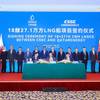2009 Toughest Test for Container Industry
Drewry Shipping Consultants, in its latest Container Forecast, concluded that 2009 will be the toughest test yet for the Container industry and further casualties are a real possibility.
During the last quarter of 2008, carriers have been doing their best to reduce capacity through suspension of a number of high profile east/west services. However, Drewry argues that the gap between supply and demand is still too big. For the short to medium term, carriers can at best only stabilize freight rates that, on the Asia to Europe trade, have recently fallen to uncommercial levels.
Drewry’s revised estimate for 2008 global container traffic growth is 152.8 million teu, representing a 7.2% year-on-year growth, down from the 8.6% they published in their previous September report, with a meagre growth of 2.8% forecast for 2009. This is certainly backed by the year-on-year throughput decline currently in evidence at the southern Chinese port of Shenzhen.
It is evident from Drewry’s fourth quarter 2008 edition of the Container Forecaster that previous long-held industry rules have changed or become skewed. This is because the downturn happened so dramatically that, supply/demand mechanics in all trades have faltered at the same time. There are no bright lights left for the industry.
The relationship between volume growth and GDP expansion has also become distorted, differentiated charter rates currently do not exist and freight rates are being determined by factors other than simply falling demand. Further, carriers and alliances are seeking vessel-sharing or service sharing agreements they would not have contemplated 12 months ago.
The undertaking of slow-steaming strategies to save fuel costs has also been turned on its head by the fall in crude prices. And the fact that east-west strings are now being operated by 10 and 11 ships with extra port calls being added just to soak up capacity. While this was mainly confined to the Asia-Europe trade, carriers are now desperately seeking any means to utilize capacity without physically laying up vessels.
Neil Dekker, the Container Forecaster editor, comments: “Shipping lines and shipowners are in a precarious position since they can do almost nothing to determine freight rates, charter rates and asset values for their ships. Even at such low prices, it is not a buyer’s market for potential charterers or ship purchasers because demand and credit lines have dried up.”
“With no likelihood of significant cancellations in 2009, the global fleet is still expected to increase by 12.7% - way ahead of demand. Even with some tonnage taken out of the market in 2010-12 through cancellations and increased annual slippage factors playing a part, this is not helping the global supply/demand balance to any significant extent. Our supply/demand index forecasts for the next four years are now very pessimistic indeed and it is expected to fall by 7% this year and by a further 3.6% in 2010.”
There are very few positives at the moment apart from the fact that bunker prices have greatly reduced and scrapping levels have increased. Carriers are continually re-assessing their capacity deployment strategies as it seems that the recent suspension of a number of east-west strings is still not bringing the supply/demand balance back into line in order to stabilize freight rate erosion.
The lay up of ships is a last course of action for the industry, but it will become more of a feature throughout 2009 as cascading of tonnage can no longer be seen as an effective capacity management tool.
“Drewry Container Forecaster” is published 4 times a year by Drewry Shipping Consultants Ltd.











